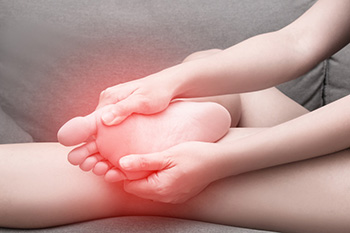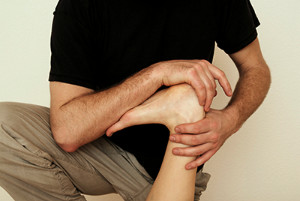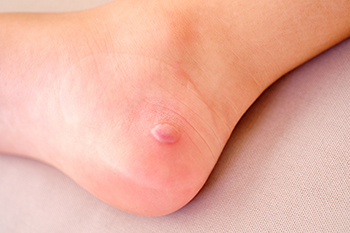Items filtered by date: June 2024
Various Reasons for Foot Pain

Sharp heel pain and general foot pain can result from several conditions. Plantar fasciitis, a common cause, is characterized by inflammation of the thick band of tissue running along the bottom of the foot. Bursitis, the inflammation of fluid-filled sacs that cushion the bones, can also lead to significant foot pain. Gout, a form of arthritis resulting from the accumulation of uric acid crystals, often causes sudden and intense discomfort in the big toe or ankle. Tarsal tunnel syndrome, involving compression of the tibial nerve, can create sharp, tingling pain extending into the arch. Additionally, heel spurs, which are bony growths on the underside of the heel, can cause stabbing pain, especially while walking or standing. If you have any type of foot pain, it is suggested that you consult a podiatrist who can determine the cause and offer treatment options.
Foot Pain
Foot pain can be extremely painful and debilitating. If you have a foot pain, consult with Renee Rodriquez, DPM from Foot Clinic of South Texas. Our doctor will assess your condition and provide you with quality foot and ankle treatment.
Causes
Foot pain is a very broad condition that could be caused by one or more ailments. The most common include:
- Bunions
- Hammertoes
- Plantar Fasciitis
- Bone Spurs
- Corns
- Tarsal Tunnel Syndrome
- Ingrown Toenails
- Arthritis (such as Gout, Rheumatoid, and Osteoarthritis)
- Flat Feet
- Injury (from stress fractures, broken toe, foot, ankle, Achilles tendon ruptures, and sprains)
- And more
Diagnosis
To figure out the cause of foot pain, podiatrists utilize several different methods. This can range from simple visual inspections and sensation tests to X-rays and MRI scans. Prior medical history, family medical history, and any recent physical traumatic events will all be taken into consideration for a proper diagnosis.
Treatment
Treatment depends upon the cause of the foot pain. Whether it is resting, staying off the foot, or having surgery; podiatrists have a number of treatment options available for foot pain.
If you have any questions, please feel free to contact our office located in Brownsville, TX . We offer the newest diagnostic and treatment technologies for all your foot care needs.
Exercises May Help Arch Pain
 Arch pain is discomfort or inflammation in the arch of the foot, often caused by overuse, flat feet, high arches, or plantar fasciitis. It can manifest as a dull ache or a sharp, stabbing pain, particularly during or after physical activity. Foot exercises can help alleviate arch pain by strengthening and stretching the muscles and tissues in the feet. One beneficial exercise is the towel curl, where you sit with your foot on a towel and use your toes to scrunch the towel towards you, repeating 10 to 15 times per foot. Another exercise is the calf stretch. This is done by facing a wall while standing, placing one foot behind the other, and bending the front knee while keeping the back leg straight. Hold for 15 to 30 seconds, and repeat several times. A third exercise is the arch roll, which is practiced by placing a tennis ball or a frozen water bottle to roll under your foot for a few minutes each day. For persistent or severe arch pain, it is suggested that you visit a podiatrist for a proper diagnosis and treatment.
Arch pain is discomfort or inflammation in the arch of the foot, often caused by overuse, flat feet, high arches, or plantar fasciitis. It can manifest as a dull ache or a sharp, stabbing pain, particularly during or after physical activity. Foot exercises can help alleviate arch pain by strengthening and stretching the muscles and tissues in the feet. One beneficial exercise is the towel curl, where you sit with your foot on a towel and use your toes to scrunch the towel towards you, repeating 10 to 15 times per foot. Another exercise is the calf stretch. This is done by facing a wall while standing, placing one foot behind the other, and bending the front knee while keeping the back leg straight. Hold for 15 to 30 seconds, and repeat several times. A third exercise is the arch roll, which is practiced by placing a tennis ball or a frozen water bottle to roll under your foot for a few minutes each day. For persistent or severe arch pain, it is suggested that you visit a podiatrist for a proper diagnosis and treatment.
Why Stretching Is Important for Your Feet
Stretching the feet is a great way to prevent injuries. If you have any concerns with your feet consult with Renee Rodriquez, DPM from Foot Clinic of South Texas. Our doctor will assess your condition and provide you with quality foot and ankle treatment.
Stretching the Feet
Stretching the muscles in the foot is an important part in any physical activity. Feet that are tight can lead to less flexibility and make you more prone to injury. One of the most common forms of foot pain, plantar fasciitis, can be stretched out to help ease the pain. Stretching can not only ease pain from plantar fasciitis but also prevent it as well. However, it is important to see a podiatrist first to determine if stretching is right for you. Podiatrists can also recommend other ways to stretch your feet. Once you know whether stretching is right for you, here are some excellent stretches you can do.
- Using a foam roller or any cylindrical object (a water bottle or soda can will do), roll the object under your foot back and forth. You should also exert pressure on the object. Be sure to do this to both feet for a minute. Do this exercise three times each.
- Similar to the previous exercise, take a ball, such as a tennis ball, and roll it under your foot while seated and exert pressure on it.
- Grab a resistance band or towel and take a seat. If you are using a towel, fold it length wise. Next put either one between the ball of your foot and heel and pull with both hands on each side towards you. Hold this for 15 seconds and then switch feet. Do this three times for each foot.
- Finally hold your big toe while crossing one leg over the other. Pull the toe towards you and hold for 15 seconds. Once again do this three times per foot.
It is best to go easy when first stretching your foot and work your way up. If your foot starts hurting, stop exercising to ice and rest the foot. It is advised that you then see a podiatrist for help.
If you have any questions, please feel free to contact our office located in Brownsville, TX . We offer the newest diagnostic and treatment technologies for all your foot care needs.
How to Avoid Development of Blisters
 Preventing blisters is important for maintaining healthy feet. One way to avoid the development of blisters is by wearing well-fitted shoes that don't rub or cause friction against your skin. Additionally, it is suggested to change socks throughout the day, as wet or sweaty feet are more likely to blister. If you are aware of a spot that may become sore when engaging in daily activities that can cause friction, such as walking, or running, consider padding the inflamed area to reduce pressure. Applying cushioning pads where blisters commonly form can provide extra protection and reduce friction. Keeping up with foot hygiene can also decrease the risk of developing a blister on the foot. Keep your toenails trimmed and smooth to prevent them from catching on your socks or shoes, which can cause rubbing and blisters. If you notice any redness or hot spots on your feet, take immediate action to prevent blisters from forming. If you have a blister, especially if it is large, painful, or showing signs of infection, it is suggested to visit a podiatrist for safe treatment.
Preventing blisters is important for maintaining healthy feet. One way to avoid the development of blisters is by wearing well-fitted shoes that don't rub or cause friction against your skin. Additionally, it is suggested to change socks throughout the day, as wet or sweaty feet are more likely to blister. If you are aware of a spot that may become sore when engaging in daily activities that can cause friction, such as walking, or running, consider padding the inflamed area to reduce pressure. Applying cushioning pads where blisters commonly form can provide extra protection and reduce friction. Keeping up with foot hygiene can also decrease the risk of developing a blister on the foot. Keep your toenails trimmed and smooth to prevent them from catching on your socks or shoes, which can cause rubbing and blisters. If you notice any redness or hot spots on your feet, take immediate action to prevent blisters from forming. If you have a blister, especially if it is large, painful, or showing signs of infection, it is suggested to visit a podiatrist for safe treatment.
Blisters are prone to making everyday activities extremely uncomfortable. If your feet are hurting, contact Renee Rodriquez, DPM of Foot Clinic of South Texas. Our doctor can provide the care you need to keep you pain-free and on your feet.
Foot Blisters
Foot blisters develop as a result of constantly wearing tight or ill-fitting footwear. This happens due to the constant rubbing from the shoe, which can often lead to pain.
What Are Foot Blisters?
A foot blister is a small fluid-filled pocket that forms on the upper-most layer of the skin. Blisters are filled with clear fluid and can lead to blood drainage or pus if the area becomes infected.
How Do Blisters Form?
Blisters on the feet are often the result of constant friction of skin and material, usually by shoe rubbing. Walking in sandals, boots, or shoes that don’t fit properly for long periods of time can result in a blister. Having consistent foot moisture and humidity can easily lead to blister formation.
Prevention & Treatment
It is important to properly care for the affected area in order to prevent infection and ease the pain. Do not lance the blister and use a Band-Aid to provide pain relief. Also, be sure to keep your feet dry and wear proper fitting shoes. If you see blood or pus in a blister, seek assistance from a podiatrist.
If you have any questions, please feel free to contact our office located in Brownsville, TX . We offer the newest diagnostic and treatment technologies for all your foot care needs.
Plantar Warts Can Be Treated!
Why Diabetic Patients Experience Foot Problems
 Diabetic patients often experience foot problems due to poor blood circulation and nerve damage, or neuropathy, caused by prolonged high blood sugar levels. Reduced blood flow can lead to slow healing of cuts and sores, while neuropathy can cause numbness, tingling, or a loss of sensation in the feet. This combination increases the risk of developing ulcers and infections, and injuries may go unnoticed. Diabetic foot symptoms include swelling, redness, warmth, and pain. Some individuals may feel a burning or sharp pain, while others might experience complete numbness. Foot deformities like hammertoes or Charcot foot can also develop causing discomfort and instability. To manage these issues, diabetic patients should maintain proper blood sugar levels, perform daily foot inspections, wear appropriate footwear, and practice good foot hygiene. Regular check-ups with a podiatrist are essential. If you have diabetes, it is strongly suggested that you seek comprehensive care from this type of doctor, who can perform regular foot evaluations and offer preventive measures tailored to diabetic needs.
Diabetic patients often experience foot problems due to poor blood circulation and nerve damage, or neuropathy, caused by prolonged high blood sugar levels. Reduced blood flow can lead to slow healing of cuts and sores, while neuropathy can cause numbness, tingling, or a loss of sensation in the feet. This combination increases the risk of developing ulcers and infections, and injuries may go unnoticed. Diabetic foot symptoms include swelling, redness, warmth, and pain. Some individuals may feel a burning or sharp pain, while others might experience complete numbness. Foot deformities like hammertoes or Charcot foot can also develop causing discomfort and instability. To manage these issues, diabetic patients should maintain proper blood sugar levels, perform daily foot inspections, wear appropriate footwear, and practice good foot hygiene. Regular check-ups with a podiatrist are essential. If you have diabetes, it is strongly suggested that you seek comprehensive care from this type of doctor, who can perform regular foot evaluations and offer preventive measures tailored to diabetic needs.
Diabetic foot care is important in preventing foot ailments such as ulcers. If you are suffering from diabetes or have any other concerns about your feet, contact Renee Rodriquez, DPM from Foot Clinic of South Texas. Our doctor can provide the care you need to keep you pain-free and on your feet.
Diabetic Foot Care
Diabetes affects millions of people every year. The condition can damage blood vessels in many parts of the body, especially the feet. Because of this, taking care of your feet is essential if you have diabetes, and having a podiatrist help monitor your foot health is highly recommended.
The Importance of Caring for Your Feet
- Routinely inspect your feet for bruises or sores.
- Wear socks that fit your feet comfortably.
- Wear comfortable shoes that provide adequate support.
Patients with diabetes should have their doctor monitor their blood levels, as blood sugar levels play such a huge role in diabetic care. Monitoring these levels on a regular basis is highly advised.
It is always best to inform your healthcare professional of any concerns you may have regarding your feet, especially for diabetic patients. Early treatment and routine foot examinations are keys to maintaining proper health, especially because severe complications can arise if proper treatment is not applied.
If you have any questions please feel free to contact our office located in Brownsville, TX . We offer the newest diagnostic and treatment technologies for all your foot and ankle needs.

